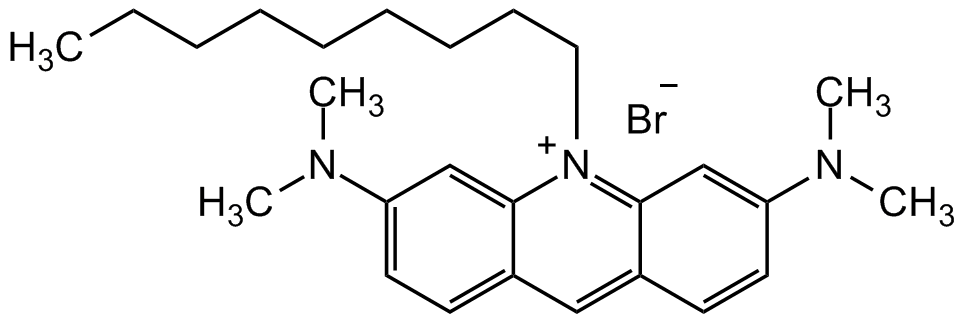Acridine orange 10-nonyl bromide
| Code | Size | Price |
|---|
| CDX-A0103-M100 | 100 mg | £145.00 |
Quantity:
Prices exclude any Taxes / VAT
Overview
Regulatory Status: RUO
Shipping:
AMBIENT
Storage:
Short Term: +20°C Long Term: +4°C
Images
Documents
Further Information
Alternate Names/Synonyms:
10-Nonylacridine orange bromide; 3,6-Bis(dimethylamino)-10-nonylacridinium bromide; 10-nonyl Acridine Orange; NAO
Appearance:
Dark red powder.
CAS:
75168-11-5
EClass:
32160000
Form (Short):
solid
Handling Advice:
Protect from light and moisture.
InChi:
InChI=1S/C26H38N3.BrH/c1-6-7-8-9-10-11-12-17-29-25-19-23(27(2)3)15-13-21(25)18-22-14-16-24(28(4)5)20-26(22)29;/h13-16,18-20H,6-12,17H2,1-5H3;1H/q+1;/p-1
InChiKey:
DRBHTUDHPPBMCD-UHFFFAOYSA-M
Long Description:
Chemical. CAS: 75168-11-5. Formula: C26H38BrN3. MW: 472.5. Acridine orange 10-nonyl is a green fluorescent mitochondrial dye. The dye incorporates into the cardiolipin-rich inner mitochondrial membrane. Acridine orange 10-nonyl has been used to study multidrug resistance and to measure changes in mitochondrial mass during apoptosis. Acridine orange 10-nonyl has been used to quantify cardiolipin content and mitochondrial mass in isolated mitochondria and cellular systems. Spectral Data: lambdaEx/lambdaEm (MeOH) = 495/522nm.
MDL:
MFCD00467605
Molecular Formula:
C26H38BrN3
Molecular Weight:
472.5
Package Type:
Vial
Product Description:
Acridine orange 10-nonyl is a green fluorescent mitochondrial dye. The dye incorporates into the cardiolipin-rich inner mitochondrial membrane. Acridine orange 10-nonyl has been used to study multidrug resistance and to measure changes in mitochondrial mass during apoptosis. Acridine orange 10-nonyl has been used to quantify cardiolipin content and mitochondrial mass in isolated mitochondria and cellular systems. Spectral Data: lambdaEx/lambdaEm (MeOH) = 495/522nm.
Purity:
>90% (HPLC)
SMILES:
CN(C)C1=CC2=[N+](CCCCCCCCC)C3=CC(N(C)C)=CC=C3C=C2C=C1.[Br-]
Solubility Chemicals:
Soluble in DMF, ethanol, DMSO or methanol.
Source / Host:
Synthetic.
Transportation:
Non-hazardous
UNSPSC Category:
Fluorescent Reagents
UNSPSC Number:
41105331
Use & Stability:
Stable for at least 2 years after receipt when stored at +4°C.
References
(1) M.H. Ratinaud, et al.; Cytometry 9, 206 (1988) | (2) A. Maftah, et al.; FEBS Letters 260, 236 (1990) | (3) D. Kessel, et al.; Cancer Res. 51, 4665 (1991) | (4) J.M. Petit, et al.; Eur. J. Biochem. 209, 267 (1992) | (5) A. Cossarizza, et al.; Exp. Cell Res. 214, 323 (1994) | (6) E. Mileykovskaya & W. Dowhan; J. Bacteriol. 182, 1172 (2000) | (7) J.F. Keij, et al.; Cytometry 39, 203 (2000) | (8) J. Jacobson, et al.; J. Neurochem. 82, 224 (2002) | (9) M.I. Garcia Fernandez, et al. Anal. Biochem. 328, 174 (2004)



